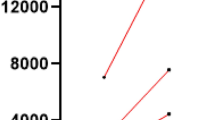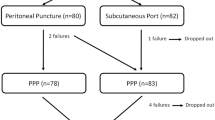Abstract
Introduction
Progressive preoperative pneumoperitoneum (PPP) is used to prepare incisional hernias with loss of domain (IHLD) operations. The aim of the present study was to analyze the effect of PPP on peritoneal volume [measured using a new computed tomography (CT)-based method] and respiratory function.
Methods
From July 2004 to July 2008, 19 patients were included in a prospective, observational study. The volumes of the incisional hernia (VIH), the abdominal cavity (VAC), the total peritoneal content (VP) and the VIH/VP ratio were measured before and after PPP using abdominal CT scan data. Spirometric parameters were measured before and after PPP, and postoperative clinical data were evaluated.
Results
Before and after PPP, the mean VIH was 1,420 cc and 2,110 cc (P < 0.01), and the mean VAC was 9,083 cc and 11,104 cc (P < 0.01). The VAC increased by 2,021 cc (P < 0.01) and was greater than the mean VIH before PPP. After PPP, the spirometric measurements revealed a restrictive syndrome. The overall postoperative morbidity rate was 37%.
Conclusions
PPP increased the hernia and abdominal volumes. PPP induced a progressive, restrictive syndrome.


Similar content being viewed by others
References
Korenkov M, Paul A, Sauerland S, Neugebauer E, Arndt M, Chevrel JP, Corcione F, Fingerhut A, Flament JB, Kux M, Matzinger A, Myrvold HE, Rath AM, Simmermacher RK (2001) Classification and surgical treatment of incisional hernia. Results of an experts’ meeting. Langenbecks Arch Surg 386:65–73
Rives J, Chevrel JP, Caix M (1987) Surgery of the abdominal wall. In: Rives J, Chevrel JP, Caix M (eds) Hernias and surgery of the abdominal wall. Springer, Berlin, pp 116–143
Dabbas N, Adams K, Pearson K, Royle G (2011) Frequency of abdominal wall hernias: is classical teaching out of date? JRSM Short Rep 2:5
Stoppa R, Ralaimiaramanana F, Henry X, Verhaeghe P (1999) Evolution of large ventral incisional hernia repair. The French contribution to a difficult problem. Hernia 3:1–3
Lowe JB 3rd, Lowe JB, Baty JD, Garza JR (2003) Risks associated with “components separation” for closure of complex abdominal wall defects. Plast Reconstr Surg 111:1276–1283
Trivellini G, Zanella G, Danelli PG, Pratolongo D, Ferri O (1984) Surgical treatment of large eventrations. Study of a technic adapted to disorders of respiratory compliance. Chirurgie 110:116–122
Munegato G, Grigoletto R, Brandolese R (2000) Respiratory mechanics in abdominal compartment syndrome and large incisional hernias; a study of 41 patients. Hernia 4:282–285
Cady B, Brooke-Cowden GL (1976) Repair of massive abdominal wall defects. Combined use of pneumoperitoneum and Marlex mesh. Surg Clin North Am 56:559–570
Paajanen H, Laine H (2005) Operative treatment of massive ventral hernia using polypropylene mesh: a challenge for surgeon and anesthesiologist. Hernia 9:62–67
Dumont F, Fuks D, Verhaeghe P, Brehant O, Sabbagh C, Riboulot M, Yzet T, Regimbeau JM (2009) Progressive pneumoperitoneum increases the length of abdominal muscles. Hernia 13:183–187
Goni Moreno I (1971) Pneumoperitoneum applied to the surgical preparation of large chronic eventrations. Prensa Med Argent 58:1037–1041
Koontz AR, Graves JW (1954) Preoperative pneumoperitoneum as an aid in the handling of gigantic hernias. Ann Surg 140:759–762
Mayagoitia JC, Suarez D, Arenas JC, Diaz de Leon V (2006) Preoperative progressive pneumoperitoneum in patients with abdominal-wall hernias. Hernia 10:213–217
Forrest J (1979) Repair of massive inguinal hernia: with pneumoperitoneum and without using prosthetic mesh. Arch Surg 114:1087–1088
Stoppa R, Louis D, Verhaeghe P, Henry X, Plachot JP (1987) Current surgical treatment of post-operative eventrations. Int Surg 72:42–44
Kingsnorth AN, Sivarajasingham N, Wong S, Butler M (2004) Open mesh repair of incisional hernias with significant loss of domain. Ann R Coll Surg Engl 86:363–366
Okamoto E, Kyo A, Yamanaka N, Tanaka N, Kuwata K (1984) Prediction of the safe limits of hepatectomy by combined volumetric and functional measurements in patients with impaired hepatic function. Surgery 95:586–592
Dello SA, van Dam RM, Slangen JJ, van de Poll MC, Bemelmans MH, Greve JW et al (2007) Liver volumetry plug and play: do it yourself with ImageJ. World J Surg 31:2215–2221
Wigmore SJ, Redhead DN, Yan XJ, Casey J, Madhavan K, Dejong CH et al (2001) Virtual hepatic resection using three-dimensional reconstruction of helical computed tomography angioportograms. Ann Surg 233:221–226
Tanaka EY, Yoo JH, Rodrigues AJ Jr, Utiyama EM, Birolini D, Rasslan S (2010) A computerized tomography scan method for calculating the hernia sac and abdominal cavity volume in complex large incisional hernia with loss of domain. Hernia 14:63–69
Goni Moreno I (1978) The rational treatment of hernias and voluminous chronic eventrations: Preparation with progressive pneumoperitoneum. Lippincott, Philadelphia
Johnson WC (1972) Preoperative progressive pneumoperitoneum in preparation for repair of large hernias of the abdominal wall. Am J Surg 124:63–68
De Santis L, Frigo F, Bruttocao A, Terranova O (2003) Pathophysiology of giant incisional hernias with loss of abdominal wall substance. Acta Biomed 74:34–37
Astudillo R, Merrell R, Sanchez J, Olmedo S (1986) Ventral herniorrhaphy aided by pneumoperitoneum. Arch Surg 121:935–936
Barst HH (1972) Pneumoperitoneum as an aid in the surgical treatment of giant herniae. Br J Surg 59:360–364
Coelho JC, Brenner AS, Freitas AT, Campos AC, Wiederkehr JC (1993) Progressive preoperative pneumoperitoneum in the repair of large abdominal hernias. Eur J Surg 159:339–341
Rives J, Pires JC, Flament JB, Palot JP (1987) Major incisional hernia. In: Chevrel JP (ed) Surgery of the abdominal wall. Springer, Berlin, pp 116–144
Pelosi P, Croci M, Ravagnan I, Tredici S, Pedoto A, Lissoni A et al (1998) The effects of body mass on lung volumes, respiratory mechanics, and gas exchange during general anesthesia. Anesth Analg 87:654–660
Tan PL, Lee TL, Tweed WA (1992) Carbon dioxide absorption and gas exchange during pelvic laparoscopy. Can J Anaesth 39:677–681
Connolly DP, Perri FR (1969) Giant hernias managed by pneumoperitoneum. JAMA 209:71–74
Kaafarani H, Hur K, Campasano M, Reda D, Itani K (2009) Classification and valuation of postoperative complications in a randomized trial of open versus laparoscopic ventral herniorraphy [abstract 221]. Hernia 13(Suppl 1):S69
Tanaka EY, Yoo JH, Rodrigues AJ Jr, Utiyama EM, Birolini D, Rasslan S (2010) A computerized tomography scan method for calculating the hernia sac and abdominal cavity volume in complex large incisional hernia with loss of domain. Hernia 14:63–69
Agnew SP, Small W Jr, Wang E, Smith LJ, Hadad I, Dumanian GA (2010) Prospective measurements of intra-abdominal volume and pulmonary function after repair of massive ventral hernias with the components separation technique. Ann Surg 251:981–988
Author information
Authors and Affiliations
Corresponding author
Rights and permissions
About this article
Cite this article
Sabbagh, C., Dumont, F., Fuks, D. et al. Progressive preoperative pneumoperitoneum preparation (the Goni Moreno protocol) prior to large incisional hernia surgery: volumetric, respiratory and clinical impacts. A prospective study. Hernia 16, 33–40 (2012). https://doi.org/10.1007/s10029-011-0849-2
Received:
Accepted:
Published:
Issue Date:
DOI: https://doi.org/10.1007/s10029-011-0849-2




